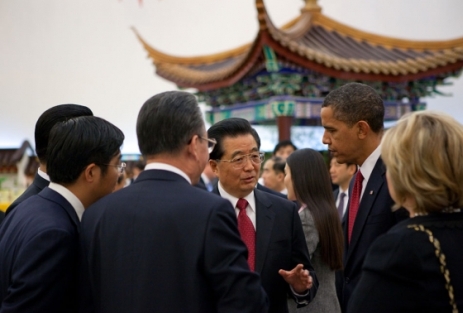China and the U.S. announced on Tuesday a Joint Statement (available here) and a package of agreed actions on clean energy. This meeting between these two countries that account for around 40 percent of the world’s CO2 emissions from fossil fuels couldn’t come at a more critical time in efforts to secure a strong international agreement to address global warming pollution (as I discussed here).
We didn’t expect big announcements on the critical issues of specific emissions reduction commitments from the two countries (hopefully that will be outlined in the coming months), but the U.S. and China did agree to some very positive shifts on a couple of fronts. These were subtle, but important, changes in the Chinese position that has occurred over the last year. Having President Obama talking about global warming with China on such frequency and at such a high-level has definitely helped with this shift.
Here are the headlines from the climate portions of the Joint Statement that struck me. (The NRDC China Program team will also provide some perspectives on the agreed package of actions on clean energy, available here).
1. Nature of the Copenhagen outcome.
There was a little buzz over the weekend, when 19 countries reportedly agreed that they would seek a framework in Copenhagen that agrees to “one agreement, two steps” (as I discussed here). Here is what the Joint U.S.-China Statement had to say on that front:
“…both sides believe that, while striving for final legal agreement, an agreed outcome at Copenhagen should … include emission reduction targets of developed countries and nationally appropriate mitigation actions of developing countries. The outcome should also substantially scale up financial assistance to developing countries, promote technology development, dissemination and transfer, pay particular attention to the needs of the poorest and most vulnerable to adapt to climate change, promote steps to preserve and enhance forests, and provide for full transparency with respect to the implementation of mitigation measures and provision of financial, technology and capacity building support” [emphasis added].
So while the U.S. and China both recognized the challenge of finalizing the legal agreement in Copenhagen (as was recognized this weekend and that I discussed here), they did stress that the agreement could be more than just a mere piece of paper that has no meaning. Rather, if such an agreement were reached in Copenhagen with the elements that they stressed, it could lead to real commitments to actions that reduce emissions while the full legal agreement is finalized. So as I said before: stay tuned as I expect we’ll have an interesting two-week ride in Copenhagen.
2. Both countries will take mitigation commitments and “stand behind them”.
Here is what they had to say on this important front: “The United States and China … resolve to take significant mitigation actions and recognize the important role that their countries play in promoting a sustainable outcome that will strengthen the world’s ability to combat climate change” [emphasis added].
While Chinese President Hu Jintao announced in September that China would take further actions to address their global warming pollution, including outlining an effort to reduce the overall global warming pollution intensity of their economy (as I discussed here and my colleague discussed here), this announcement codifies that this commitment will be forthcoming. And given that they also agreed that the Copenhagen Agreement should include “mitigation actions of developing countries,” it now appears clear that the Chinese will commit to those actions in an international agreement. It wasn’t clear before whether China would just have those as domestic commitments or whether they would also translate them into international commitments (as I discussed here) so this is a positive change.
And they also announced that:
“The two sides resolve to stand behind these commitments” [emphasis added].
This is a shift from the previous Chinese position in that they weren’t willing to “open up their books and defend them” in the same way that the U.S. would (as I discussed here).
So that means that China and the U.S. agreed that they would both have to commit to these emissions reduction actions internationally and they would be held accountable for them. Both of these signal a subtle, but important shift that will help make China more accountable to meet their commitments.
3. Both countries actions to reduce emissions will be fully transparent.
Both sides agreed that the international agreement should: “…provide for full transparency with respect to the implementation of mitigation measures and provision of financial, technology and capacity building support” [emphasis added].
This didn’t go as far as we ultimately need on the transparency of actions, but the Chinese did move from their previous position. The Chinese have been saying before that they wouldn’t subject all their actions to international scrutiny. And now they are at least saying that those actions would need to be done with “full transparency”. And as a part of this agreement they signed a Memorandum of Cooperation between the Environmental Protection Agency of the United States and the National Development and Reform Commission of China and to Build Capacity to Address Climate Change. As my colleague has discussed (see here) there are steps that would need to be taken to “build confidence on U.S.-China climate actions.” Hopefully this shift and cooperation agreement will provide further flesh to the important “transparency” issue of Chinese and U.S. actions.
—–
In addition to these overarching shifts, the two sides did also agree to a set of joint actions that will hopefully produce tangible reductions in global warming pollution and deployment of clean energy.
So while the U.S. and China didn’t agree to the big ticket items — the specific emissions reductions objectives — which we ultimately need them to commit to, there were some important shifts in the Chinese position.
Hopefully we’ll see even more shifts in the coming couple of weeks (and months). The shifts from these two key countries have a very big impact on the overall stability of the international efforts to address global warming.




